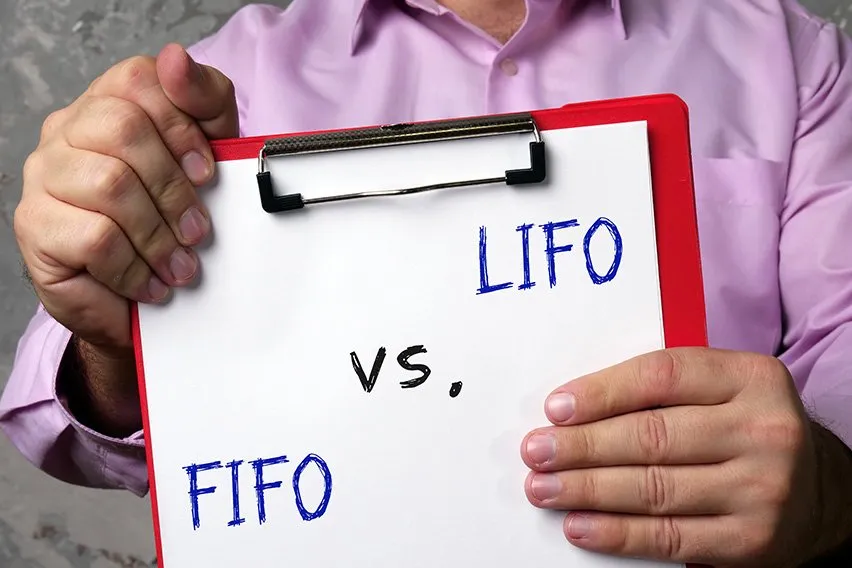How to Calculate FIFO and LIFO

To calculate FIFO (First-In, First Out) determine the cost of your oldest inventory and multiply that cost by the amount of inventory sold, whereas to calculate LIFO (Last-in, First-Out) determine the cost of your most recent inventory and multiply it by the amount of inventory sold.
The FIFO (“First-In, First-Out”) method means that the cost of a company’s oldest inventory is used in the COGS (Cost of Goods Sold) calculation. LIFO (“Last-In, First-Out”) means that the cost of a company’s most recent inventory is used instead.
Key Takeaways
- FIFO and LIFO are methods of calculating inventory value and Cost of Goods Sold.
- FIFO, or First In, First Out, assumes that the oldest inventory is sold first.
- LIFO, or Last In, First Out, assumes that the newest inventory is the first to be sold.
- Choosing FIFO or LIFO will have different impacts on your inventory value assessment.
Table of Contents:
- What Is FIFO?
- How To Calculate FIFO
- What Is LIFO?
- How To Calculate LIFO
- Improve Inventory Management with FreshBooks
What Is FIFO?
FIFO, or First In, First Out, is an inventory valuation method that assumes that inventory bought first is disposed of first. When a business calculates its Cost of Goods Sold (COGS) and the value of its remaining inventory, FIFO is a common inventory valuation method used to determine the value of Cost of Goods Sold and your remaining inventory assets.
Using FIFO does not necessarily mean that all the oldest inventory has been sold first—rather, it’s used as an assumption for calculation purposes. Learn more about what FIFO is and how it’s used to decide which inventory valuation methods are the right fit for your business.

How To Calculate FIFO
To calculate FIFO, multiply the amount of units sold by the cost of your oldest inventory. If the number of units sold exceeds the number of oldest inventory items, move on to the next oldest inventory and multiply the excess amount by that cost.
For example, if you sold 15 units, you would multiply that amount by the cost of your oldest inventory. However, if you only had 10 units of your oldest inventory in stock, you would multiply 10 units sold by the oldest inventory price, and the remaining 5 units by the price of the next oldest inventory. Using the FIFO inventory method, this would give you your Cost of Goods Sold for those 15 units.
FIFO Method Formula
The formula for calculating Cost of Goods Sold using the FIFO inventory valuation method is:
Cost of Goods Sold = Number of Units Sold x Cost of Oldest Inventory
- Cost of Goods Sold is the value of all the goods that your company sells.
- Number of Units Sold is the number of units of the good that your company sold in the period being calculated.
- Cost of Oldest Inventory follows the cost system discussed in the last section, where you start with the cost of your oldest inventory, followed by the next oldest inventory, and so on.
FIFO Example
Lee’s Lighting buys and resells lamps. Here’s a look at what it’s been costing Lee to build up his inventory since his store opened:
| Month | Amount | Price Paid |
| October | 100 lamps | $50.00 per |
| November | 100 lamps | $85.00 per |
| December | 100 lamps | $100.00 per |
Let’s say on January 1st of the new year, Lee wants to calculate the cost of goods sold in the previous year. Lee has sold 80 lamps so far.
COGS calculation is as follows:
80 x $50.00 = $4000.
(Because Lee is going by the FIFO method, he is using the oldest cost of $50.00 per lamp in the calculation.)
What Is LIFO?
LIFO, or Last In, First Out, is an inventory value method that assumes that the goods bought most recently are the first to be sold. When calculating inventory and Cost of Goods Sold using LIFO, you use the price of the newest goods in your calculations.
Learn more about what LIFO is and its impact on net income to decide if LIFO valuation is right for you.
How To Calculate LIFO
To calculate the Cost of Goods Sold (COGS) using the LIFO method, determine the cost of your most recent inventory. Multiply it by the amount of inventory sold.
As with FIFO, if the price to acquire the products in inventory fluctuates during the specific time period you are calculating COGS for, that has to be taken into account.
Let’s say you’ve sold 15 items, and you have 10 new items in stock and 10 older items. You would multiply the first 10 by the cost of your newest goods, and the remaining 5 by the cost of your older items to calculate your Cost of Goods Sold using LIFO.
LIFO Method Formula
To calculate your Cost of Goods Sold using the LIFO accounting method, use the following formula:
Cost of Goods Sold = Number of Units x Cost of Newest Inventory
- Cost of Goods Sold is the total value of the goods that your company sold.
- Number of Units Sold refers to how many units of the good your company sold in the period under calculation.
- Cost of Newest Inventory follows a similar method to that of FIFO, where you use the cost of your newest goods followed by your next newest goods, and so on.
LIFO Example
It looks like Lee picked a bad time to get into the lamp business. The costs of buying lamps for his inventory went up dramatically during the fall, as demonstrated under ‘price paid’ per lamp in November and December. So, Lee decides to use the LIFO method, which means he will use the price it cost him to buy lamps in December.
COGS calculation is as follows:
80 x $100.00 = $8,000.
(Because Lee is going by the LIFO method, he is using the most recent cost of $100.00 per lamp in the calculation.)
Although using the LIFO method will cut into his profit, it also means that Lee will get a tax break. The 220 lamps Lee has not yet sold would still be considered inventory, and their value would be based on the prices not yet used in the calculation.
The difference between the LIFO and FIFO calculation is $4000. That difference is called the LIFO reserve. It is the amount by which a company’s taxable income has been deferred by using the LIFO method.

Improve Inventory Management with FreshBooks
FIFO and LIFO are helpful tools for calculating the value of your business’s inventory and Cost of Goods Sold. FIFO assumes that your oldest goods are sold first, while LIFO assumes that your newest goods are sold first.
Keeping track of all incoming and outgoing inventory costs is key to accurate inventory valuation. FreshBooks expense tracking software makes it easy to organize common expenses like inventory purchases, while the financial reporting feature generates automatic reports for tracking and sharing FIFO, LIFO, profits, and more. Try FreshBooks for free to boost your efficiency and improve your inventory management today.
Reviewed by
Michelle Payne has 15 years of experience as a Certified Public Accountant with a strong background in audit, tax, and consulting services. Michelle earned a Bachelor’s of Science and Accounting from Minnesota State University and has provided accounting support across a variety of industries, including retail, manufacturing, higher education, and professional services. She has more than five years of experience working with non-profit organizations in a finance capacity. Keep up with Michelle’s CPA career — and ultramarathoning endeavors — on LinkedIn.
RELATED ARTICLES


 How To Prepare An Income Statement
How To Prepare An Income Statement Single-Entry Bookkeeping: Single-Entry vs Double-Entry
Single-Entry Bookkeeping: Single-Entry vs Double-Entry What Are the Different Types of Accounting Systems? Options Explained
What Are the Different Types of Accounting Systems? Options Explained How to Be Your Own Accountant in 7 Steps
How to Be Your Own Accountant in 7 Steps CPA vs Accountant: What Is the Difference?
CPA vs Accountant: What Is the Difference? How Much Do Accountants Charge for a Small Business? It Depends on Your Needs
How Much Do Accountants Charge for a Small Business? It Depends on Your Needs